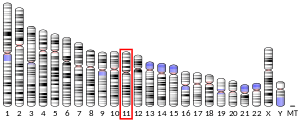SIPA1
Signal-induced proliferation-associated protein 1 is a protein that in humans is encoded by the SIPA1 gene.[5][6]
The product of this gene is a mitogen induced GTPase activating protein (GAP). It exhibits a specific GAP activity for Ras-related regulatory proteins Rap1 and Rap2, but not for Ran or other small GTPases. This protein may also hamper mitogen-induced cell cycle progression when abnormally or prematurely expressed. It is localized to the perinuclear region. Two alternatively spliced variants encoding the same isoform have been characterized to date.[6]
References
- GRCh38: Ensembl release 89: ENSG00000213445 - Ensembl, May 2017
- GRCm38: Ensembl release 89: ENSMUSG00000056917 - Ensembl, May 2017
- "Human PubMed Reference:". National Center for Biotechnology Information, U.S. National Library of Medicine.
- "Mouse PubMed Reference:". National Center for Biotechnology Information, U.S. National Library of Medicine.
- Wada Y, Kubota H, Maeda M, Taniwaki M, Hattori M, Imamura S, Iwai K, Minato N (Mar 1997). "Mitogen-inducible SIPA1 is mapped to the conserved syntenic groups of chromosome 19 in mouse and chromosome 11q13.3 centromeric to BCL1 in human". Genomics. 39 (1): 66–73. doi:10.1006/geno.1996.4464. PMID 9027487.
- "Entrez Gene: SIPA1 signal-induced proliferation-associated gene 1".
Further reading
- Minato N (1997). "[Regulatory mechanisms of lymphocyte proliferation: roles of Spa-1 gene]". Hum. Cell. 9 (1): 11–6. PMID 9183624.
- Hattori M, Tsukamoto N, Nur-e-Kamal MS, et al. (1995). "Molecular cloning of a novel mitogen-inducible nuclear protein with a Ran GTPase-activating domain that affects cell cycle progression". Mol. Cell. Biol. 15 (1): 552–60. PMC 232010. PMID 7799964.
- Bonaldo MF, Lennon G, Soares MB (1997). "Normalization and subtraction: two approaches to facilitate gene discovery". Genome Res. 6 (9): 791–806. doi:10.1101/gr.6.9.791. PMID 8889548.
- Kurachi H, Wada Y, Tsukamoto N, et al. (1997). "Human SPA-1 gene product selectively expressed in lymphoid tissues is a specific GTPase-activating protein for Rap1 and Rap2. Segregate expression profiles from a rap1GAP gene product". J. Biol. Chem. 272 (44): 28081–8. doi:10.1074/jbc.272.44.28081. PMID 9346962.
- Ebrahimi S, Wang E, Udar N, et al. (1998). "Genomic organization and cloning of the human homologue of murine Sipa-1". Gene. 214 (1–2): 215–21. doi:10.1016/S0378-1119(98)00212-1. PMID 9651531.
- Tsukamoto N, Hattori M, Yang H, et al. (1999). "Rap1 GTPase-activating protein SPA-1 negatively regulates cell adhesion". J. Biol. Chem. 274 (26): 18463–9. doi:10.1074/jbc.274.26.18463. PMID 10373454.
- Hoecker U, Quail PH (2001). "The phytochrome A-specific signaling intermediate SPA1 interacts directly with COP1, a constitutive repressor of light signaling in Arabidopsis". J. Biol. Chem. 276 (41): 38173–8. doi:10.1074/jbc.M103140200. PMID 11461903.
- Roy BC, Kohu K, Matsuura K, et al. (2003). "SPAL, a Rap-specific GTPase activating protein, is present in the NMDA receptor-PSD-95 complex in the hippocampus". Genes Cells. 7 (6): 607–17. doi:10.1046/j.1365-2443.2002.00546.x. PMID 12059963.
- Strausberg RL, Feingold EA, Grouse LH, et al. (2003). "Generation and initial analysis of more than 15,000 full-length human and mouse cDNA sequences". Proc. Natl. Acad. Sci. U.S.A. 99 (26): 16899–903. doi:10.1073/pnas.242603899. PMC 139241. PMID 12477932.
- Farina A, Hattori M, Qin J, et al. (2004). "Bromodomain Protein Brd4 Binds to GTPase-Activating SPA-1, Modulating Its Activity and Subcellular Localization". Mol. Cell. Biol. 24 (20): 9059–69. doi:10.1128/MCB.24.20.9059-9069.2004. PMC 517877. PMID 15456879.
- Gerhard DS, Wagner L, Feingold EA, et al. (2004). "The Status, Quality, and Expansion of the NIH Full-Length cDNA Project: The Mammalian Gene Collection (MGC)". Genome Res. 14 (10B): 2121–7. doi:10.1101/gr.2596504. PMC 528928. PMID 15489334.
- Crawford NP, Ziogas A, Peel DJ, et al. (2006). "Germline polymorphisms in SIPA1 are associated with metastasis and other indicators of poor prognosis in breast cancer". Breast Cancer Res. 8 (2): R16. doi:10.1186/bcr1389. PMC 1483843. PMID 16563182.
- Olsen JV, Blagoev B, Gnad F, et al. (2006). "Global, in vivo, and site-specific phosphorylation dynamics in signaling networks". Cell. 127 (3): 635–48. doi:10.1016/j.cell.2006.09.026. PMID 17081983.
This article is issued from Wikipedia. The text is licensed under Creative Commons - Attribution - Sharealike. Additional terms may apply for the media files.



